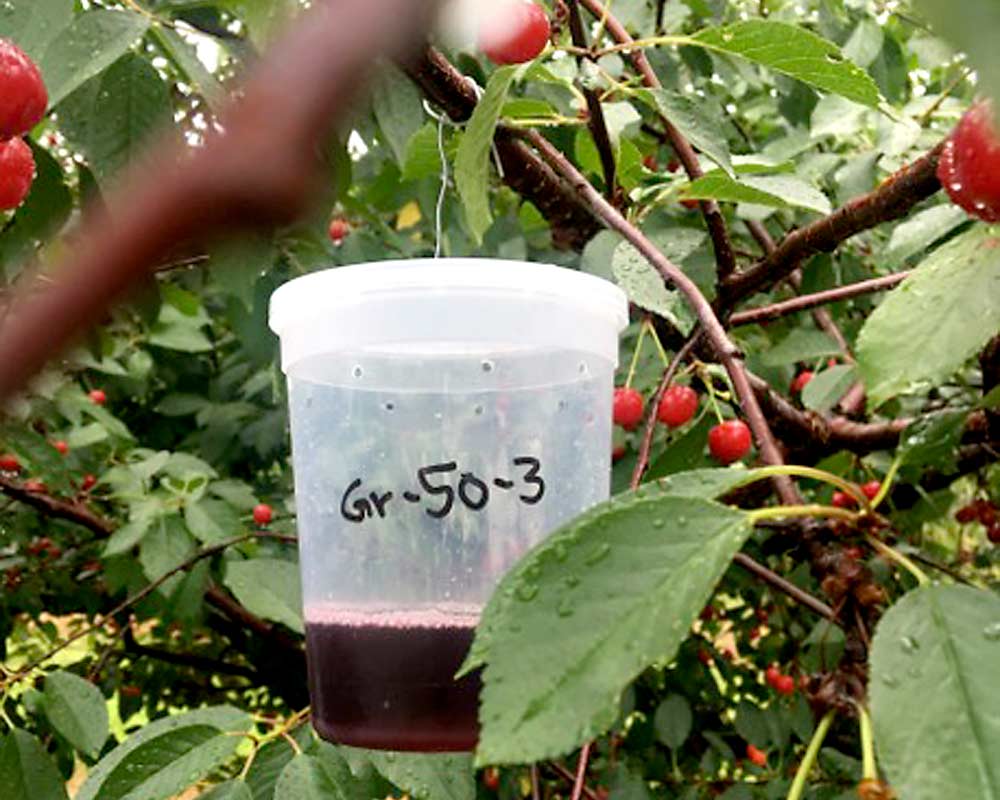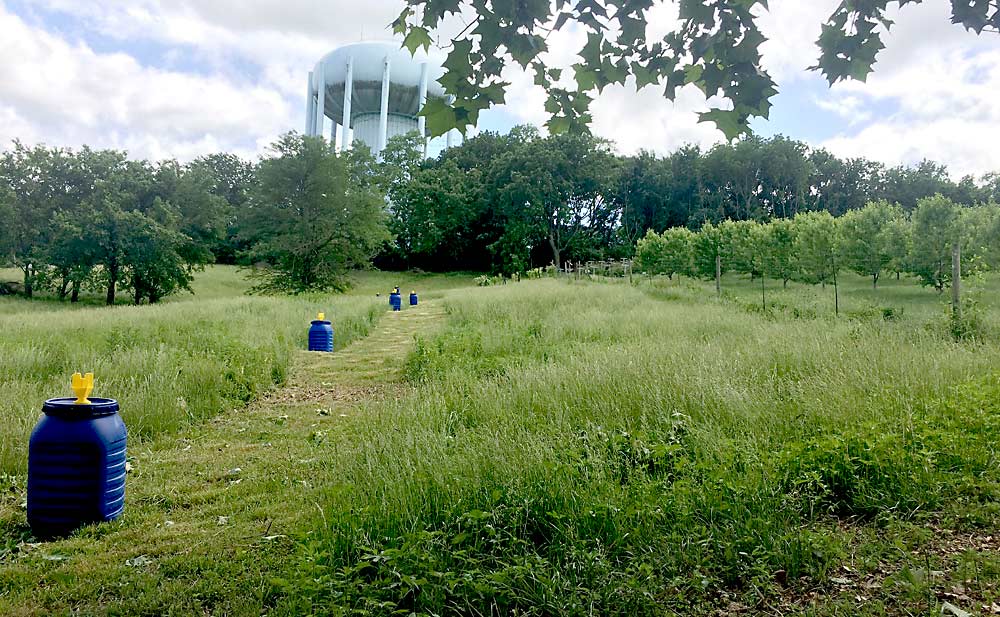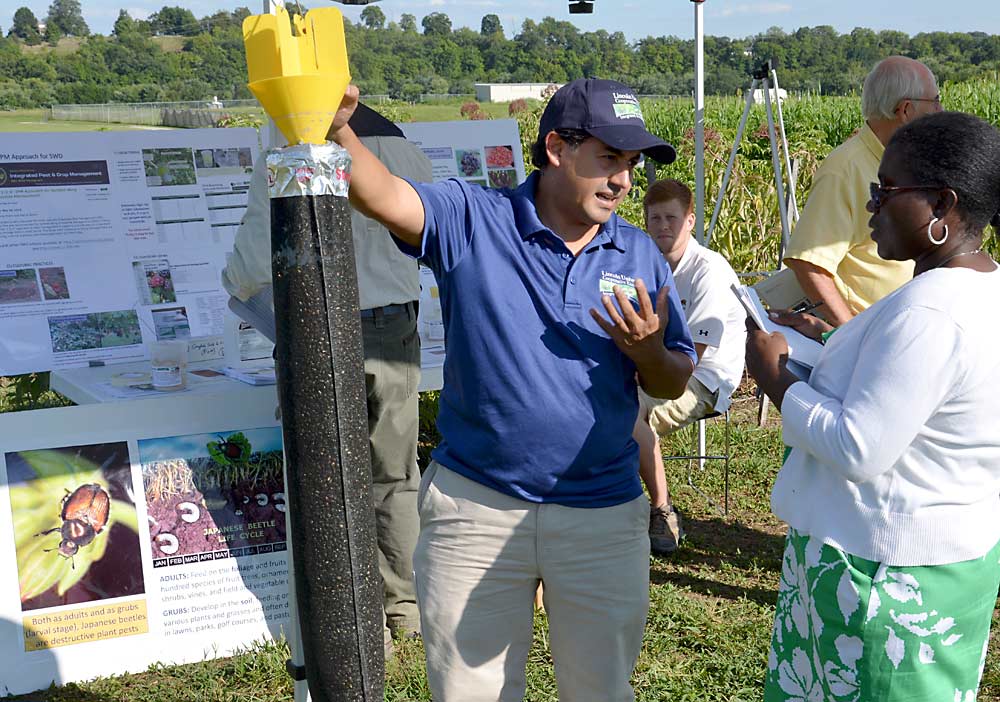
New England berry growers want organic pest control options, so University of Massachusetts Extension associate professor Jaime Piñero decided to explore the potential of low-cost trapping techniques.
For spotted wing drosophila, he found strong success using traps baited with diluted grape juice — better than the commercial lures he compared them to — so he’s planning to test that trap as the foundation for a mass trapping experiment this summer. In 2017, he also finished a six-year research project in Missouri that showed mass trapping provides effective control of Japanese beetles.
You catch more flies with juice?
In cherry and peach blocks at the UMass Cold Spring Orchard, Piñero compared traps baited with diluted Concord grape juice to others containing a variety of commercial lures. On average, the grape juice captured three times more SWD, yet the cost for the diluted grape juice was 8 cents per trap, compared to $5 to $7 per commercial lure.
Surprisingly, he saw more SWD specificity from the juice traps.
“Because the commercial lures are based on fermentation materials, they attract other insects, including different species of Drosophila and other nontarget insects,” Piñero said. “I found that the most effective and cheapest option was the Concord grape juice at the 1:3 ratio, so one part juice and three parts water.”
The grape juice drew in more SWD than other fruit flies and caught more female than male SWDs, while commercial lures attracted more males.
Piñero plans to verify his 2018 findings with another study this summer before definitively recommending the method to growers. Both the 2018 and the upcoming work are funded by the Massachusetts Department of Agricultural Resources Specialty Crop Block Grant Program.
In addition, Piñero is planning experiments in 2020 to find ways to make the grape juice stay fresh longer. Currently, the Concord grape juice in the traps has to be replaced once or twice a week so that it doesn’t ferment and begin to attract nontarget species, he said.
He is also planning to test whether the juice traps could be used as a mass-trapping method in conjunction with insecticide applications.
“I’m especially interested in the early-season period, so before your crop is susceptible and you begin spraying insecticides,” Piñero said. “What would happen if you deployed 20 or 40 traps along the perimeter of a 1-acre field two weeks before you have to spray? How many would you kill before you started spraying? Would that prevent the population from increasing?”
He is looking for a half-dozen or so blueberry fields in which to conduct the evaluation this summer.
“For the last 15 years I have been working with small growers, so I understand how difficult it is for them to use options that are expensive, including for monitoring purposes,” he said. So far, diluted grape juice looks like a good option. “The benefits of the grape juice are it’s cheap, it’s easy to find, it’s effective and it also attracts fewer nontargets,” he said.
Beetles flock to trash-can traps

Plastic trash cans provide the foundation of a Japanese beetle trap that works like a charm, Piñero said. In a 2.5-acre organic blueberry field that was part of his trial, “we did not spray a single drop of insecticide in six years because the mass-trapping system was working well,” he said. Piñero conducted the study at Lincoln University of Missouri, where he was an associate professor/state integrated pest management specialist before joining the University of Massachusetts in 2018. The research was funded by the USDA National Institute of Food and Agriculture (NIFA) Evans-Allen Research Program and the Missouri Department of Agriculture.
The trap is a simple device: Adult Japanese beetles enter a yellow funnel baited with a lure that combines a floral-based attractant and Japanese beetle sex pheromone. They then fall into an attached container. Early in the study, Piñero used a 4-foot-long mesh sock as the container, but he switched to a design with a 32-gallon trash can modified to add two screen-covered windows for airflow. He described the trash-can design as more “grower friendly” because it is easier to construct and holds more beetles.
Seven trash-can traps, which is enough for 1 acre, cost $213.50 to construct, plus the cost of two lures per season per trap, which Piñero estimated at about $59.50. Maintenance includes only adding the second lure partway through the season and emptying the catch as needed, which is usually just twice a season.
So far, Piñero has only tested the system on elderberries and blueberries, but if grape or other fruit growers ask, he said he would consider doing a demonstration project or small research project in another crop.

Brandon Taylor, owner of Taylor Family Orchard in Liberty, Missouri, already tried out the system on his organically grown peaches and apples. After trying unsuccessfully to fight the beetles for several years, he saw an article on Piñero’s work and decided to give the trash-can traps a try. He made and set out 15 traps in 2018 along the northern and eastern perimeters of a 2-acre orchard.
He slightly modified Piñero’s design by using 55-gallon barrels, instead of 32-gallon trash cans, and drilling holes for air flow rather than installing the screen windows. At first, the traps didn’t pull in many beetles, so he resorted to spraying with Surround. “When I got a good coating of Surround on the trees, the beetles started going to the traps and I really didn’t have too many problems (with beetles) for the remainder of the year,” he said.
In 2019, he added four more traps to encircle the 2 acres of peaches and apples. He isn’t sure if the weather played a role or if the traps helped depress the population, but the population of beetles last year was extremely low. Either way, though, he plans to continue using the traps.
“They’re going to be a permanent fixture,” Taylor said. “The cost of the lures is pretty inexpensive and I’ve already purchased the barrels, so it’s just a matter of spending about $50 a year to purchase new lures. It’s a small investment and even if, worst case scenario, they only get rid of a third of the beetles, it’s still easy to set out the barrels and let them do their thing.” •
—by Leslie Mertz






Leave A Comment